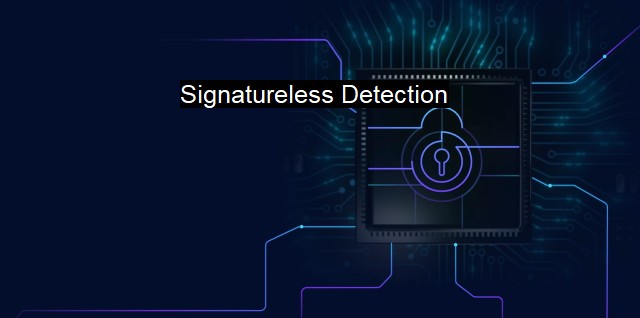What is Signatureless Detection?
Revolutionizing Cybersecurity: The Rise of Signatureless Detection in Advanced Malware Defense
Signatureless detection, also referred to as behavior-based detection, is a cybersecurity technique that uses advanced machine learning algorithms and artificial intelligence to identify malicious behavior or unusual network patterns. Unlike signature-based detection which identifies a known threat by scanning for a specific piece of code or 'signature', Signatureless detection looks at behavior analysis and threat identification instead. This emerging method in cybersecurity and antivirus protection offers an enhanced line of defense against unrelenting and ever-evolving cyber threats.Simply put, with traditional antivirus protection, the antivirus software relies on a database of known threats – the signatures – to detect viruses and malware. These signatures will allow the antivirus to quickly scan a computer or network, identify a malicious file if it matches the signature, and eradicate or contain it. this traditional signature-based method of detection was characterized with high false positives and was often ineffective against new threats without corresponding signatures in the database. It was simply ineffective in a world where an estimated 350,000 new pieces of malicious software are created every single day.
In order to address the inherent shortcomings of signature-based detection, cybersecurity experts pivoted towards a revolutionary approach – signatureless detection. This cyber threat detection approach rests heavily on machine learning and artificial intelligence capabilities, where a system is trained to learn what 'normal' behavior looks like on a network, or set of systems. It then continuously monitors and identifies deviations or unusual behaviors, which could signify an attack. It's a more preventive method as it proactively secures the network instead of the reactive approach of signature-based detection.
Signatureless detection has multiple layers to it. It deals with static analysis, dynamic analysis, and machine learning. Static Analysis involves examining the software without actually executing it to look for potentially malicious code. Dynamic Analysis is examining the software while it's in operation. Through this, it checks for malicious behaviors and exploits them. Both of these analysis methods are accomplished through machine learning, which involves training models using a vast quantity of data, and artificial intelligence, which aids in decision making.
This approach is highly effective for identifying previously undiscovered (zero-day) threats, or any modified version of malware that might go unrecognized via the signature-based route. It's also effective at catching ransomware, a cyber threat that attacks the victims’ data and restricts access unless a ransom is paid. Ransomware often changes its code to escape signature-based detection and hence signatureless detection using behavior analysis is now paramount.
Signatureless detection has its own sets of limitations. Firstly, it requires a significant amount of computational resources. It also needs a lot of standard communication, which often is a bandwidth-consuming process. the interpretation of the results requires a high degree of expertise because of the sheer volume and complexity of the data analyzed.
While signatureless detection can help anticipate new threats based on behavioral pattern analysis, it may struggle to differentiate between legitimate abnormalities and malicious behavior leading to false positives, rendering the method a little less precise than desirable.
Embracing signatureless detection implies accepting a paradigm shift from classic, signature-based detection techniques. By combining these two - we have the present and future of cybersecurity and antivirus protection. An effective security strategy now integrates both signature and signatureless detection. They complement each other in a way that the deficiencies of one method are offset by the strengths in the other, providing a complete, integrated solution. So, security professionals now have a more powerful tool in their arsenal to protect their digital assets.
In today's landscape of varied and evolving threats, the role of signatureless detection is incredibly crucial. It is paving the way for improved cybersecurity measures and is a key mechanism in the antivirus software of today and tomorrow. The sophisticated and rapid detection allowed by signatureless methods presents a potent challenge to would-be attackers and increasingly sophisticated malware.

Signatureless Detection FAQs
What is signatureless detection?
Signatureless detection, also known as behavioral analysis, is a cybersecurity technique that identifies malicious behavior and patterns rather than relying on known signatures or code.How does signatureless detection work?
Signatureless detection examines the behavior and actions of software and processes to identify abnormal or malicious behavior. It can analyze file activity, network traffic, system calls, and other factors to detect potential threats.What are the benefits of signatureless detection?
Signatureless detection can detect new and emerging threats that may not have known signatures, providing a more comprehensive and proactive approach to cybersecurity. It can also reduce the number of false positives that traditional signature-based antivirus solutions may generate.Is signatureless detection more effective than traditional antivirus solutions?
Signatureless detection is not necessarily more effective than traditional antivirus solutions, but it provides a more dynamic and adaptive approach to cybersecurity. Combining both signature-based and signatureless detection can provide comprehensive protection against known and unknown threats.| | A | | | B | | | C | | | D | | | E | | | F | | | G | | | H | | | I | | | J | | | K | | | L | | | M | |
| | N | | | O | | | P | | | Q | | | R | | | S | | | T | | | U | | | V | | | W | | | X | | | Y | | | Z | |
| | 1 | | | 2 | | | 3 | | | 4 | | | 7 | | | 8 | | |||||||